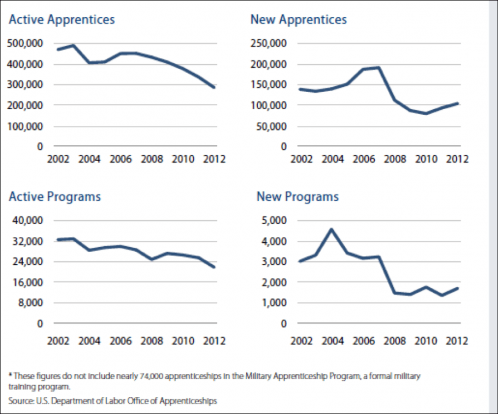Growing Skills Gap
According to the Accenture 2013 Skills and Employment Trends Survey, 46% of executives are concerned they won’t have the skills they need in the next one to two years and there are real consequences…
- 66% anticipate a loss of business to competitors
- 64% face a loss of revenue
- 53% anticipate a delay in developing new products and services
In 2012 Deloitte found that there were 600,000 unfilled manufacturing jobs in the U.S. “simply because employers cannot find people with the skills they need.” In 2013 a Manpower Group survey found that 48 per cent of U.S. employers have a hard time filling jobs because candidates lacked the right technical competencies. Even if these figures overstate the skills shortage with the average age of a high skill manufacturing worker in the U.S. being 56 years old, skills shortages are likely to increase as they retire.
Sponsored content - article continues below
Trending eLearning Content Providers
The U.S. Apprenticeship Gap
Despite the need for more skilled employees, the number of apprenticeships in the U.S. has been declining as is shown below.

In contrast, Germany has 1.8 million apprentices. In the UK there were 520,000 new entrants into apprenticeships in 2011-12. In Switzerland 77 per cent of students begin a training program with a portable certification. 20 per cent of apprenticeships in Switzerland are in white collar jobs. However, the use of apprenticeships is relatively low in the U.S. compared to other countries. In 2012 there were only 358,000 registered apprenticeships.
Are Apprenticeships only for Blacksmiths and Welders?
The term apprenticeship can bring a set of preconceptions. In the U.S. people often think of the traditional apprenticeships sponsored by unions or trade associations, but apprenticeship programs are being used from everything from maintenance engineer to sales to social media. And increasingly apprenticeship programs are being delivered within companies as part of their onboarding program or to up-skill a segment of the employee population. The growing use of apprenticeships by U.S. companies been profiled in major publications. The New York Times profiled Tognum America’s program for diesel engine builders and the Wall Street Journal highlighted programs at Volkswagen, Siemens and Bosch.
Is Your Organization Ready To Leverage An Apprenticeship Model?
There does appear to be an opportunity in the U.S. to develop in-work training programs that leverage an apprenticeship model. One of the biggest barriers appears to be lack of awareness and misconceptions about apprenticeships. Apprenticeships are applicable much wider than the traditional unionized workforce with significant growth in white collar apprenticeships in other countries.It is also not always appreciated that apprenticeships are real jobs. Wages typically start at 50 to 60 per cent of the final wages. This benefits both the employer and the apprentice. Apprentices get hands on training and an education with little or no educational debt, which is a major attraction for participants and an obstacle for the same group when seeking further education. Employers get motivated and loyal employees at a reasonable cost and can build a pipeline of skilled workers.Apprentices also gain from a career and learning journey. Apprentices can receive certifications that are recognized and portable. Apprenticeships that combine on-the-job training and education can lead on to an Associate or Bachelor degrees. Furthermore, major Universities like the
Apprentices also gain from a career and learning journey. Apprentices can receive certifications that are recognized and portable. Apprenticeships that combine on-the-job training and education can lead on to an Associate or Bachelor degrees. Furthermore, major Universities like the
It is also not always appreciated that apprenticeships are real jobs. Wages typically start at 50 to 60 per cent of the final wages. This benefits both the employer and the apprentice. Apprentices get hands on training and an education with little or no educational debt, which is a major attraction for participants and an obstacle for the same group when seeking further education. Employers get motivated and loyal employees at a reasonable cost and can build a pipeline of skilled workers.
Apprentices also gain from a career and learning journey. Apprentices can receive certifications that are recognized and portable. Apprenticeships that combine on-the-job training and education can lead on to an Associate or Bachelor degrees. Furthermore, major Universities like the University of Wisconsin are implementing competency-based models. This counters the notion that apprenticeships are in some way inferior to traditional academic education.Evidence on the effectiveness and return on investment of apprenticeships is strong. At City & Guilds in the UK there is significant research on the benefits of apprenticeships. Even in the U.S. they are ‘overwhelmingly recommended by employers and lead to significant increases in lifetime earnings.”There appears to be a real opportunity for apprenticeships in the U.S. If you would like to learn more about how Kineo, a City & Guilds business, can help you to develop internal apprenticeship programs in a wide range of areas.
Evidence on the effectiveness and return on investment of apprenticeships is strong. At City & Guilds in the UK there is significant research on the benefits of apprenticeships. Even in the U.S. they are ‘overwhelmingly recommended by employers and lead to significant increases in lifetime earnings.”There appears to be a real opportunity for apprenticeships in the U.S. If you would like to learn more about how Kineo, a City & Guilds business, can help you to develop internal apprenticeship programs in a wide range of areas.
Evidence on the effectiveness and return on investment of apprenticeships is strong. At City & Guilds in the UK there is significant research on the benefits of apprenticeships. Even in the U.S. they are ‘overwhelmingly recommended by employers and lead to significant increases in lifetime earnings.”There appears to be a real opportunity for apprenticeships in the U.S. If you would like to learn more about how Kineo, a City & Guilds business, can help you to develop internal apprenticeship programs in a wide range of areas.
Evidence on the effectiveness and return on investment of apprenticeships is strong. At City & Guilds in the UK there is significant research on the benefits of apprenticeships. Even in the U.S. they are ‘overwhelmingly recommended by employers and lead to significant increases in lifetime earnings.”There appears to be a real opportunity for apprenticeships in the U.S. If you would like to learn more about how Kineo, a City & Guilds business, can help you to develop internal apprenticeship programs in a wide range of areas.













